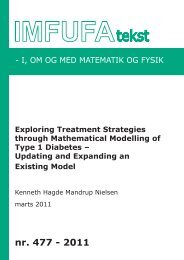ABSTRACT ALGEBRAIC STRUCTURES OPERATIONS AND ...
ABSTRACT ALGEBRAIC STRUCTURES OPERATIONS AND ...
ABSTRACT ALGEBRAIC STRUCTURES OPERATIONS AND ...
Create successful ePaper yourself
Turn your PDF publications into a flip-book with our unique Google optimized e-Paper software.
102. Definition: The equivalence relation induced by a subgroup<br />
The equivalence relation established in the preceding theorem is said to be the<br />
left equivalence relation induced by H. The equivalence classes are said to be<br />
the left cosets for H.)<br />
It is obvious to define right equivalence relation and right cosets analogously.<br />
Lets give some interpretation of what is going on here. Imagine that the elements<br />
in G have some property (call it their color). You should think of the<br />
elements h in the subgroup H to be so that their action doesn’t change the<br />
colour, by what we mean that ah has the same colour as a. Then the coset aH<br />
consists of the elements with the same colour. If H consists of all the ”neutral”<br />
elements then each coset represents a specific colour. Here are two examples<br />
X40 and X41<br />
103. Theorem: A Left coset for a subgroup is the image of H by a<br />
bijection.<br />
The left cosets have the form aH and are the result of a left translation of H.<br />
The mapping h ↦→ ah is a bijection of H on aH.<br />
Similar for right cosets.<br />
Proof : Let ∼ denote the left equivalence corresponding to H. This means<br />
per definition that b ∼ a ⇔ b ∈ aH. This shows that [a] = aH. Let La denote<br />
left translation with a that means that La(x) = ax. Then La(H) = aH. Left<br />
translation with an invertible element in a monoid is injective (T85). And in<br />
a group all elements are invertible .<br />
You have maybe met this result in the situation in X42. X43<br />
104. Definition: Index for subgroup<br />
If H is a subgroup in G then we define the index for H to be the number<br />
(possibly ∞) of left cosets and we denote it by [G : H]. Notice that we would<br />
have the same number if we had used the right cosets<br />
X44 X45<br />
105. Theorem: Lagrange’s theorem<br />
58
















